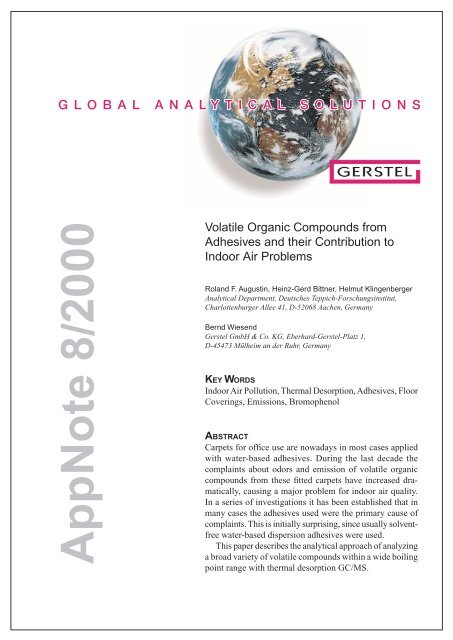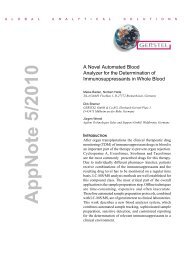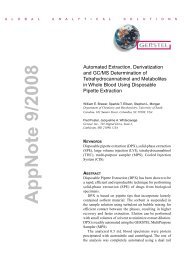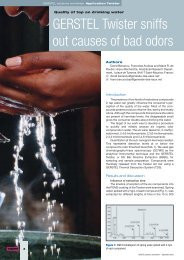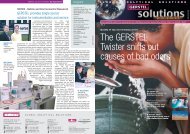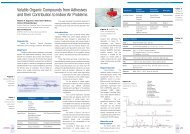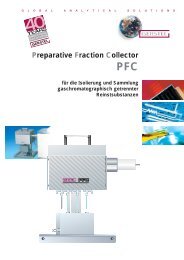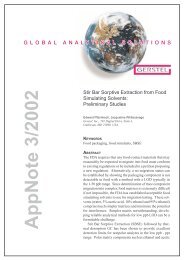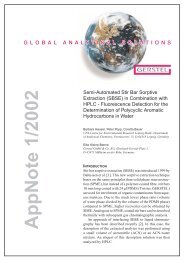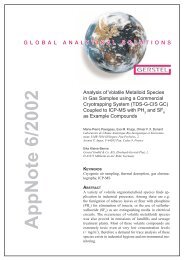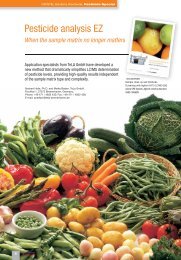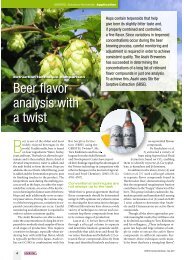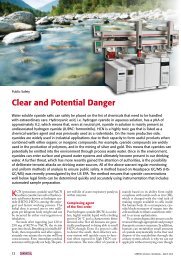AppNote-2000-08 - Gerstel
AppNote-2000-08 - Gerstel
AppNote-2000-08 - Gerstel
You also want an ePaper? Increase the reach of your titles
YUMPU automatically turns print PDFs into web optimized ePapers that Google loves.
<strong>AppNote</strong> 8/<strong>2000</strong><br />
Volatile Organic Compounds from<br />
Adhesives and their Contribution to<br />
Indoor Air Problems<br />
Roland F. Augustin, Heinz-Gerd Bittner, Helmut Klingenberger<br />
Analytical Department, Deutsches Teppich-For schungs in sti tut,<br />
Charlottenburger Allee 41, D-52068 Aachen, Germany<br />
Bernd Wiesend<br />
<strong>Gerstel</strong> GmbH & Co. KG, Eberhard-<strong>Gerstel</strong>-Platz 1,<br />
D-45473 Mülheim an der Ruhr, Germany<br />
KEY WORDS<br />
Indoor Air Pollution, Thermal Desorption, Adhesives, Floor<br />
Coverings, Emissions, Bromophenol<br />
ABSTRACT<br />
Carpets for office use are nowadays in most cases applied<br />
with water-based adhesives. During the last decade the<br />
complaints about odors and emission of volatile organic<br />
compounds from these fitted carpets have increased dramatically,<br />
causing a major problem for indoor air quality.<br />
In a series of investigations it has been established that in<br />
many cases the adhesives used were the primary cause of<br />
complaints. This is initially surprising, since usually sol ventfree<br />
water-based dispersion adhesives were used.<br />
This paper describes the analytical approach of analyzing<br />
a broad variety of volatile compounds within a wide boiling<br />
point range with thermal desorption GC/MS.
INTRODUCTION<br />
In the early 90´s, due to a German worker safety regulation (TRGS 610), solvent based adhesives for floorcoverings<br />
were changed to water-based dispersions. To realize this change in technology, instead of low boiling<br />
solvents such as methanol and toluene high boiling components such as Phenoxy ethanol, miscellaneous glycols<br />
and glycolethers were used. These components still do have the function of a solvent, but due to the solvent<br />
definition of the regulation (boiling point < 200°C), the adhesives have been declared solvent-free.<br />
These high boiling and polar components have been identified as a major source of problems caused by<br />
glued carpets. Due to their low vapor pressure, the high boiling components diffuse only very slowly from the<br />
adhesive through the textile floorcovering, but can cause long-term indoor air pollution. Adhesives for textile<br />
floorcoverings do not only contain these high boiling components but also other components, such as terpenes<br />
or other volatile organic compounds as shown in Table I.<br />
Table I. Volatile organic compounds from water-based dispersion adhesives.<br />
Compound<br />
Source<br />
Terpenes Pinene Colophony resin<br />
Limonene<br />
Carene<br />
Longifolene<br />
Isolongifolene<br />
Glycol ethers Butyldiglycol Soft resins and solubilizer<br />
Butyldiglycol acetate<br />
Phenoxy ethanol<br />
Phenoxy propanol<br />
Alcohols 2-Ethylhexanol Emulgators and defoamer<br />
Esters Acryl acid esters Acrylic resins<br />
For the analysis of volatile organic compounds in indoor air, various sampling techniques and different adsorbing<br />
materials are in use (Figure 1). The sampling strategies depend on the boiling point of the components.<br />
Chromosorb, Porapack<br />
Carbotrap<br />
Tenax TA<br />
Activated charcoal (solvent)<br />
XAD, PUF (solvent)<br />
VVOC VOC SVOC POM<br />
380 C<br />
b.p.<br />
Carbon based molecular sieves<br />
Figure 1. Boiling point range of VOC's and applicable adsorbents.<br />
As a common adsorbent, activated charcoal tubes are regularly used for the determination of volatile organic<br />
compounds. However, this type of adsorbent is not suitable for the detection of high boiling and polar compounds,<br />
such as glycols and glycolethers found in water-based adhesives.<br />
AN/<strong>2000</strong>/<strong>08</strong> - 2
Table II. Comparison of different adsorbents and their suitability for different compound classes.<br />
Adsorbents Suitable Compounds Unsuitable Compounds Desorption<br />
Activated carbon Aromatics Glycol ethers Carbon bisulfi de<br />
Aliphatics<br />
Terpenes<br />
Polars (Phenols)<br />
Silicagel Polars Non-polars Ethanol<br />
Tenax TA<br />
Compounds of a wide boiling point Boiling points below 60°C Thermal<br />
range with different polarities<br />
As shown in Figure 2, the use of activated charcoal for the sampling of these components will lead to severely<br />
biased analytical results and incomplete information for the interpretation of the indoor air situation.<br />
Abundance<br />
5e+06<br />
2<br />
4<br />
5 7<br />
Activated<br />
carbon<br />
5e+06<br />
4 7<br />
12<br />
8<br />
Silicagel<br />
8<br />
5e+06<br />
1<br />
3<br />
2 4<br />
12<br />
5 6<br />
7<br />
10<br />
9<br />
11<br />
Tenax<br />
Time--> 4.00 8.00 12.00 16.00 20.00 24.00<br />
28.00<br />
Figure 2. Comparison of different adsorbents for indoor air analysis.<br />
Table III. List of compounds.<br />
No. Compound<br />
No. Compound<br />
1 Butanol 7 2-Ethyl Hexanol<br />
2 Toluene 8 Phenoxy Ethanol<br />
3 Hexanal 9 4-Phenyl Cyclohexene<br />
4 Butyl Acetate 10 Longifolene<br />
5 Styrene 11 Isolongifolene<br />
6 Butyl Diglycol 12 Butyl Diglycol Acetate<br />
AN/<strong>2000</strong>/<strong>08</strong> - 3
According to these data, for the determination of volatile<br />
organic components from adhesives the adsorption<br />
on Tenax TA, in combination with Thermodesorption<br />
and GC/MS analysis is nowadays state of the art (Figure<br />
3: <strong>Gerstel</strong> Thermodesorption system). Only this<br />
technique is suitable for the analysis of a broad variety<br />
of volatile compounds with a wide range of boiling<br />
points and different polarity.<br />
EXPERIMENTAL<br />
Instrumentation. The analytical system consists of a<br />
thermodesorption system with autosampler (TDS A,<br />
TDS 2, <strong>Gerstel</strong> GmbH & Co.KG, Mül heim an der Ruhr,<br />
Germany, Figure 3), a temperature programmable vaporization<br />
inlet (CIS 4, <strong>Gerstel</strong>), a gas chromatograph<br />
(6890, Agilent Technologies, Little Falls, USA) and a<br />
mass selective detector (5973, Agilent).<br />
Figure 3. <strong>Gerstel</strong> TDS system with autosampler mounted<br />
on 6890 GC with 5973 MSD.<br />
Operation. The air samples are drawn on a Tenax TA tube, which is then introduced into the thermal desorption<br />
unit and thermally desorbed to release the trapped organic compounds into the cryogenically precooled PTV<br />
for sub se quent GC/MS analysis.<br />
Analysis conditions.<br />
Table IV. Analysis conditions.<br />
Tube<br />
Tenax TA, 60/80 mesh, 160 mg<br />
Column 30 m HP VOC (Agilent), di = 0.2 mm, df = 1.1 µm<br />
Pneumatics<br />
He, Pi = 170 kPa, constant pressure<br />
TDS-desorption fl ow = 50 ml/min (splitless)<br />
PTV-splitfl ow = 50 ml/min<br />
TDS<br />
PTV<br />
Oven<br />
Detector<br />
10°C (2 min), 30°C/min, 250°C, 40°C/min, 300°C (6 min)<br />
-150°C (1 min), 8°C/s, 250°C, 10°C/s, 320°C (6 min)<br />
35°C (2 min), 25°C/min, 70°C, 6°C/min, 150°C, 10°C/min, 280°C (20 min)<br />
MSD, 230°C / 150°C, Scan 34-450 amu<br />
RESULTS AND DISCUSSION<br />
As shown above, these high boiling and polar components are not only difficult to detect, but can also influence<br />
the ambient indoor air to a great extent. Compared to low boiling solvents, these chemicals tend to migrate<br />
slowly out of the adhesive into the textile floorcovering and will furthermore lead to ongoing emissions of the<br />
material. Figure 4 shows a chromatogram of an air sample taken in a test chamber above a pure adhesive in<br />
comparison to one of a fitted carpet containing the same adhesive after 7 days (Figure 5).<br />
AN/<strong>2000</strong>/<strong>08</strong> - 4
Abundance<br />
1.6e+07<br />
1.4e+07<br />
1<br />
2<br />
7 8<br />
1.2e+07<br />
1.0e+07<br />
8.0e+06<br />
6.0e+06<br />
4<br />
3<br />
6<br />
4.0e+06<br />
2.0e+06<br />
5<br />
Time--> 10.00 20.00<br />
Figure 4. Adhesive after 7 days.<br />
30.00<br />
Abundance<br />
1.6e+07<br />
1.4e+07<br />
7<br />
1.2e+07<br />
1.0e+07<br />
8.0e+06<br />
2<br />
6<br />
6.0e+06<br />
4.0e+06<br />
2.0e+06<br />
1<br />
4<br />
3 5<br />
Time--> 10.00 20.00<br />
Figure 5. Adhesively fitted carpet after 7 days.<br />
30.00<br />
Table V. List of compounds.<br />
No. Compound<br />
No. Compound<br />
1 Butyl Diglycol 5 Butyl Diglycol Acetate<br />
2 Methoxypropenyl Benzene 6 Terpene<br />
3 Phenoxy Ethanol 7 Longifolene<br />
4 Dimethylbicycloheptene Ethanol 8 Butyl Tryglycol<br />
AN/<strong>2000</strong>/<strong>08</strong> - 5
Another experiment is shown in Figure 6.<br />
For the determination of long-term emissions<br />
from adhesives (prediction for real<br />
rooms), a chamber measurement has been<br />
performed over 100 days. A carpet, glued<br />
on a glass plate was measured for this long<br />
period of time in a test chamber (Figure 7)<br />
to obtain more information concerning the<br />
long-term emission behavior of glycols and<br />
glycol ethers.<br />
An actual situation similar to the test<br />
chamber model, was observed after the<br />
new construction of the TFI-building.<br />
Instead of vaporizing within the first days<br />
after installation of a new carpet, one<br />
TVOC-concentration<br />
( g/m‡)<br />
700<br />
600<br />
500<br />
400<br />
300<br />
200<br />
100<br />
0<br />
0 1000 <strong>2000</strong> 3000<br />
time (h)<br />
1000<br />
Figure 6. Long-term emission (TVOC) of a glued<br />
carpet in a test chamber.<br />
Concentration [ g/m 3 ]<br />
1200<br />
of the adhesives used, containing these high boiling<br />
800<br />
600<br />
400<br />
377<br />
879<br />
655<br />
1127<br />
352<br />
204<br />
200<br />
55<br />
67,7<br />
88,7<br />
0<br />
0<br />
Sampling 27.01.97 20.03.97 28.07.97 07.<strong>08</strong>.97 01.09.97<br />
736<br />
Phenoxy ethanol<br />
Sum Terpenes<br />
Sum all compounds<br />
599<br />
110 74,6<br />
532<br />
Figure 8. Real room situation in a newly constructed office<br />
building.<br />
compounds, has lead to a long lasting emission of<br />
volatile components into the indoor air. As shown in<br />
Figure 8 in a real room situation these high-boiling<br />
components, such as phenoxy ethanol, do not appear<br />
immediately, but instead after a period of time after<br />
installation. In this particular case, the office had to be<br />
renovated after nine months due to the complaints of<br />
the users and according to the emission data.<br />
Another example shows that air analysis alone does<br />
not necessarily solve indoor air odor problems. In this<br />
case an extremely annoying bad smell was reported<br />
in an office room. Indoor air analysis resulted in the<br />
detection of bromophenol (Figure 9), but neither the<br />
floor covering nor the adhesive contained<br />
even traces of this compound. The combination<br />
of carpet and adhesive led to the<br />
formation of bromophenol and placing a<br />
piece of carpet (with the adhesive applied)<br />
in the thermal desorption unit and performing<br />
thermal extraction could reproduce<br />
the bad smell.<br />
Figure 7. Test chamber.<br />
AN/<strong>2000</strong>/<strong>08</strong> - 6
Abundance<br />
6e+06<br />
6<br />
9<br />
5e+06<br />
5<br />
4e+06<br />
3e+06<br />
2e+06<br />
1e+06<br />
1<br />
2<br />
4<br />
3<br />
7<br />
8<br />
10 11<br />
12<br />
Time--> 4.00 8.00 12.00 16.00<br />
Figure 9. Direct thermal extraction of carpet material and an adhesive.<br />
20.00<br />
Table VI. List of compounds.<br />
No. Compound<br />
No. Compound<br />
1 Butanol 7 Bromophenol<br />
2 Methyl Propionic Acid 8 Phenoxy Propanone<br />
3 Butylisopropylene Glycol 9 Phenoxy Propanol<br />
4 Benzaldehyde 10 4-Phenyl Cyclohexene<br />
5 Phenol 11 Isolongifolene<br />
6 2-Ethyl Hexanol 12 Longifolene<br />
Figure 10 shows the mechanism of formation: phenoxy<br />
propanol (from the adhesive) is hydrolyzed to<br />
phenol, which itself reacts with inorganic bromide<br />
(from the latex back of the textile covering) forming<br />
bromophenol.<br />
O CH 2 CH 2 CH 3<br />
Phenoxy Propanol<br />
OH<br />
Phenol<br />
Figure 10. Mechanism of formation of bromophenol.<br />
OH<br />
+ Br - OH<br />
+<br />
CH 3<br />
CH 2<br />
Br<br />
2-Bromophenol<br />
O<br />
C<br />
H<br />
CONCLUSIONS<br />
Volatile organic components from water-based adhesives<br />
have a major influence on the indoor air quality.<br />
Due to the use of high-boiling and po lar compounds,<br />
the impact of the problem has been shifted from the<br />
installation process to the consumer or inhabitant of<br />
the office. The emissions of these compounds are a<br />
major problem of indoor air pollution. As shown in<br />
this paper, the influence of adhesive components on<br />
the long-term emission is substantial and by using the<br />
wrong analytical technique the true magnitude of the<br />
problem for the indoor air situation can be severly<br />
underestimated.<br />
After having learned about the situation, a new<br />
testing scheme for the long-term emission of adhesives<br />
was developed by the association of adhesive<br />
manufacturers and the association of environmentally<br />
friendly carpets.<br />
AN/<strong>2000</strong>/<strong>08</strong> - 7
GERSTEL GmbH & Co. KG<br />
Eberhard-<strong>Gerstel</strong>-Platz 1<br />
D-45473 Mülheim an der Ruhr<br />
Germany<br />
+49 (0) 2<strong>08</strong> - 7 65 03-0<br />
+49 (0) 2<strong>08</strong> - 7 65 03 33<br />
gerstel@gerstel.com<br />
www.gerstel.com<br />
GERSTEL Worldwide<br />
GERSTEL, Inc.<br />
701 Digital Drive, Suite J<br />
Linthicum, MD 21090<br />
USA<br />
+1 (410) 247 5885<br />
+1 (410) 247 5887<br />
sales@gerstelus.com<br />
www.gerstelus.com<br />
GERSTEL AG<br />
Wassergrabe 27<br />
CH-6210 Sursee<br />
Switzerland<br />
+41 (41) 9 21 97 23<br />
+41 (41) 9 21 97 25<br />
gerstel@ch.gerstel.com<br />
www.gerstel.ch<br />
GERSTEL K.K.<br />
1-3-1 Nakane, Meguro-ku<br />
Tokyo 152-0031<br />
SMBC Toritsudai Ekimae Bldg 4F<br />
Japan<br />
+81 3 5731 5321<br />
+81 3 5731 5322<br />
info@gerstel.co.jp<br />
www.gerstel.co.jp<br />
GERSTEL LLP<br />
Level 25, North Tower<br />
One Raffles Quay<br />
Singapore 048583<br />
+65 6622 5486<br />
+65 6622 5999<br />
SEA@gerstel.com<br />
www.gerstel.com<br />
GERSTEL Brasil<br />
Av. Pascoal da Rocha Falcão, 367<br />
04785-000 São Paulo - SP Brasil<br />
+55 (11)5665-8931<br />
+55 (11)5666-9<strong>08</strong>4<br />
gerstel-brasil@gerstel.com<br />
www.gerstel.com.br<br />
Information, descriptions and specifications in this<br />
Publication are subject to change without notice.<br />
GERSTEL, GRAPHPACK and TWISTER are registered<br />
trademarks of GERSTEL GmbH & Co. KG.<br />
© Copyright by GERSTEL GmbH & Co. KG<br />
Awarded for the<br />
active pursuit of<br />
environmental sustainability


